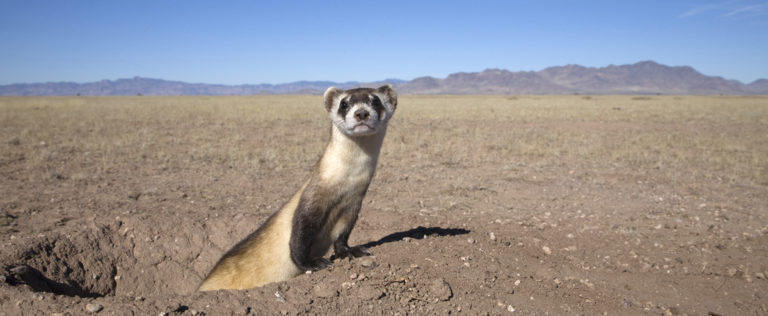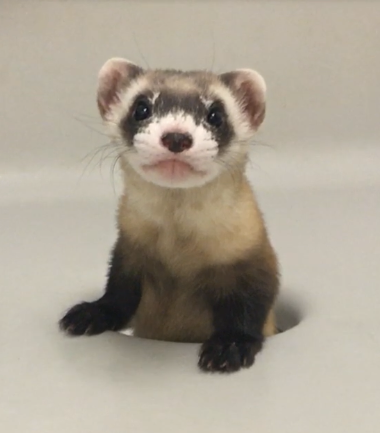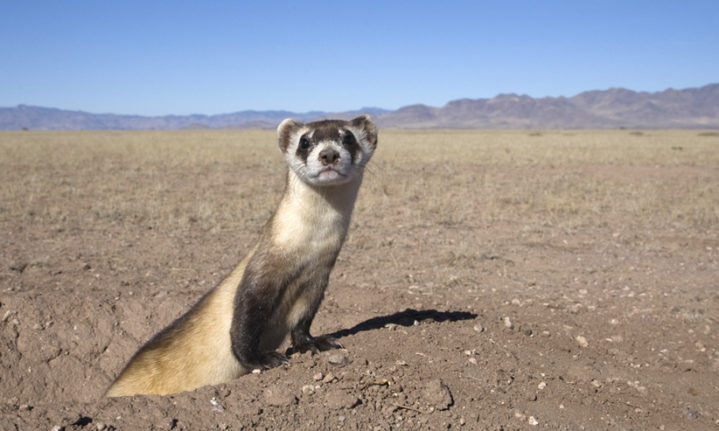A ferret named Elizabeth-Anne has become the world’s first cloned mammal in a mission to save the endangered species taking place in the United States.

The black-footed ferret (Mustela nigripes) disappeared from the wild as a consequence of the eradication of prairie dogs from 98% of their range (prairie dogs are the main prey of the ferret, and they live year-round in the prairie dog burrows). Picture: Black-Footed Ferret Connections
The black-footed ferret is one of North America’s most endangered species, and Elizabeth-Anne’s first birthday was a major milestone, which was celebrated by baking her a two-tiered cake made of prairie dog, mouse carcasses and minced meat.
Her first birthday was significant because she is the first cloned endangered species to reach sexual maturity.

Elizabeth-Anne. Picture: US Fish and Wildlife Services
Anne will now play a vital role in North America’s Ferret breeding program, where the species became one of the first animals to be placed under the then-new US Endangered species act in 1973.
In 1985, officials made the decision to round up all the wild ferrets they could find, with the hopes of starting a captive breeding programme to prevent extinction. They managed to capture 18 individuals, but only seven survived to breeding maturity. This put the species at risk of inbreeding, which can erode reproductive fitness.
Cloning in conservation
Elizabeth-Anne was cloned from a ferret that died 35 years ago, owing her existence to biologist Oliver Ryder, the geneticist that was also involved in sequencing the quagga DNA in 1984, the first time DNA was sequenced from an extinct animal.
Ryder was part of the San Diego Frozen Zoo, an effort that aimed to preserve the genetic material from a wide range of endangered species. Today, this effort has resulted in an NPO called Revive and Restore, which aims to bring biotechnologies to conservation biology with the mission to enhance biodiversity through the genetic rescue of endangered and extinct animals.
Ryder managed to preserve a cell line between one male, and a single female named Willa. To shore up the ferret’s genetic diversity, the ferret breeding program turned into the Frozen Zoo in 2013, which sought to bolster the population’s diversity by transforming the small vials of ferret cells into breathing ferrets.
Cloning for conservation purposes has a bit of a patchy history, where attempts to create clones from endangered species such as the European mouflon and the Banteng cattle resulted in offspring that died quite young.
And now, Elizabeth-Anne is poised to make history this year, as the breeding project searches for a suitable bachelor in an effort to introduce greater diversity to the population. If she gives birth to healthy kits, it will mark the first time conservation biologists have been able to integrate cloning into an effort to save a species from extinction.
‘Everything about Elizabeth-Anne is much bigger than the science behind it, and it’s much bigger than helping the ferrets,’ Ben Novak told Science.org, black-footed ferret project leader for Revive & Restore. ‘It’s about whether biotechnology can become a part of mainstream conservation.’
Biologists still hope to clone the DNA of the male ferret, simply known as Stud #2, but for now, Elizabeth-Anne’s suitable mate is being sought, where her DNA could be added to the population, whose genetic variation declined by 55% since the 1970s.
ALSO READ

















